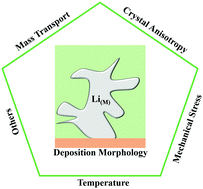Regulating electrodeposition morphology of lithium: towards commercially relevant secondary Li metal batteries
Abstract
Lithium, the lightest and most electronegative metallic element, has long been considered the ultimate choice as a battery anode for mobile, as well as in some stationary applications. The high electronegativity of Li is, however, a double-edged sword—it facilitates a large operating voltage when paired with essentially any cathode, promising a high cell-level energy density. It is also synonymous with a high chemical reactivity and low reduction potential. The interfaces a Li metal anode forms with any other material (liquid or solid) in an electrochemical cell are therefore always mediated by one or more products of its chemical or electrochemical reactions with that material. The physical, crystallographic, mechanical, electrochemical, and transport properties of the resultant new material phases (interphases) regulate all interfacial processes at a Li metal anode, including electrodeposition during battery recharge. This Review takes recent efforts aimed at manipulating the structure, composition, and physical properties of the solid electrolyte interphase (SEI) formed on an Li anode as a point of departure to discuss the structural, electrokinetic, and electrochemical requirements for achieving high anode reversibility. An important conclusion is that while recent reports showing significant advances in the achievement of highly reversible Li anodes, e.g. as measured by the coulombic efficiency (CE), raise prospects for as significant progress towards commercially relevant Li metal batteries, the plateauing of achievable CE values to around 99 ± 0.5% apparent from a comprehensive analysis of the literature is problematic because CE values of at least 99.7%, and preferably >99.9% are required for Li metal cells to live up to the potential for higher energy density batteries offered by the Li metal anode. On this basis, we discuss promising approaches for creating purpose-built interphases on Li, as well as for fabricating advanced Li electrode architectures for regulating Li electrodeposition morphology and crystallinity. Considering the large number of physical and chemical factors involved in achieving fine control of Li electrodeposition, we believe that achievement of the remaining ∼0.5% in anode reversibility will require fresh approaches, perhaps borrowed from other fields. We offer perspectives on both current and new strategies for achieving such Li anodes with the specific aim of engaging established contributors and newcomers to the field in the search for scalable solutions.

- This article is part of the themed collection: Electrochemistry in Energy Storage and Conversion


 Please wait while we load your content...
Please wait while we load your content...